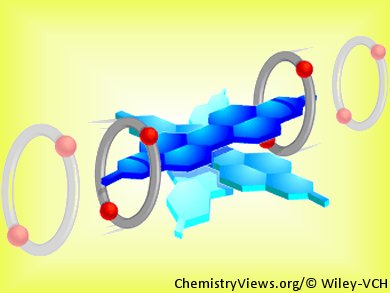Molecules that undergo both homophilic and heterophilic recognition processes could be incorporated into molecular electronic devices, solar cells, and other integrated devices. Examples of π-electronic organic molecules that exhibit both hetero- and homophilic recognition are rare.
The diazaperopyrenium cation (MP2+) is one such chameleonic molecule, that is, it can undergo both heterophilic and homophilic recognition processes. Researchers led by J. Fraser Stoddart, Northwestern University, USA, and the Korea Advanced Institute of Science and Technology (KAIST), Daejon, have shown that the solid-state superstructure of this planar aromatic molecule comprises a continuous π stack of MP2+ units and can form single needlelike crystals on surfaces. This type of π−π stacking is common for radical cations but rare for dications.
Having established the homophilic recognition properties of MP2+, Stoddart and his team then investigated its heterophilic recognition behavior and found that it is bound by electron-rich polyether macrocycles. They then took advantage of this heterophilic templating effect to prepare a series of rotaxanes with MP2+ cores, including a rare example of two donor rings threaded through one MP2+ receptor (pictured).

- The Chameleonic Nature of Diazaperopyrenium Recognition Processes,
A. N. Basuray, H.-P. Jacquot de Rouville, K. J. Hartlieb, T. Kikuchi, N. L. Strutt, C. J. Bruns, M. W. Ambrogio, A.-J. Avestro, S. T. Schneebeli, A. C. Fahrenbach, J. F. Stoddart,
Angew. Chem. Int. Ed. 2012, 51, 11872–11877.
DOI: 10.1002/anie.201205089 - Angew. Chem. 2012, 124 12042–12047.
DOI: 10.1002/ange.201205089




